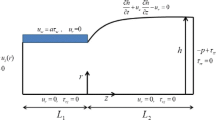Abstract
The extrudate swell of a viscoelastic fluid through an orifice die is investigated by using a mixed finite element and a streamline integration method (FESIM), using a version of the K-BKZ model. The free surface calculation is based on a local mass conservation scheme and an approximate numerical treatment for the contact point movement of the free surface. The numerical results show a vortex growth and an increasing swelling ratio with the Weissenberg number. Convergence with mesh refinement is demonstrated, even at a high Weissenberg number of O(587), where the swelling ratio reaches a value of about 360%. In addition, it is found that the effective flow channel at the entrance region next to the orifice die is reduced due to the enhanced vortex growth, which may be a source of flow instability.
Similar content being viewed by others
References
Barakos G, Mitsoulis E (1995 a) Numerical simulation of extrusion through orifice dies and prediction of Bagley correction for an IUPAC-LDPE melt. J Rheol 39:193–209
Barakos G, Mitsoulis E (1995b) A convergence study for the numerical simulation of the IUPAC-LPDE extrusion experiments. J Non-Newt Fluid Mech 58:315–329
Caswell B, Viriyayuthakorn M (1983) Finite element simulation of die swell for a Maxwell fluid. J Non-Newt Fluid Mech 12:13–29
Delvaux V, Crochet MJ (1990) Numerical simulation of delayed die swell. Rheol Acta 29:1–10
Goublomme A, Draily B, Crochet MJ (1992) Numerical prediction of extrudate swell of a high-density polyethylene. J Non-Newt Fluid Mech 44:171–195
Luo X-L, Tanner RI (1986a) A streamline element scheme for solving viscoelastic flow problems. Part 1: differential constitutive equations. J Non-Newt Fluid Mech 21:179–199
Luo X-L, Tanner RI (1986b) A streamline element scheme for solving viscoelastic flow problems. Part II: integral constitutive models. J Non-Newt Fluid Mech 22:61–89
Luo X-L, Tanner RI (1988) Finite element simulation of long and short circular die extrusion experiments using integral models. Int J Num Meth Eng 25:9–22
Luo X-L, Mitsoulis E (1990) An efficient algorithm for strain history tracking in finite element computations of nonNewtonian fluids with integral constitutive equations. Int J Num Meth Fluids 11:1015–1031
Meissner J (1975) Basic parameters, melt theology, processing and end-use properties of three similar low density polyethylene samples. Pure Appl Chem 42:551–612
Papanastasiou AC, Scriven LE, Macosko CW (1983) An integral constitutive equation for mixed flows: viscoelastic characterization. J Rheol 27:387–410
Sun J, Tanner RI (1994) Computation of steady flow past a sphere in a tube using a PTT integral model. J Non-Newt Fluid Mech 54:379–403
Sun J, PhanThien N, Tanner RI (1995) ‘Viscoelastic flow between two opposing orifices’. J Non-Newt Fluid Mech (in press)
Tanner RI (1988) Engineering Rheology. Oxford University Press, Oxford
Author information
Authors and Affiliations
Rights and permissions
About this article
Cite this article
Sun, J., Phan-Thien, N. & Tanner, R.I. Extrudate swell through an orifice die. Rheol Acta 35, 1–12 (1996). https://doi.org/10.1007/BF00366548
Received:
Accepted:
Issue Date:
DOI: https://doi.org/10.1007/BF00366548




